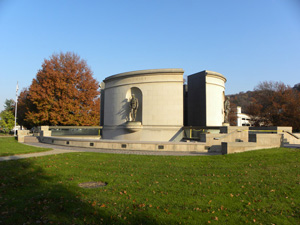

Remember...
Carl Jefferson Smith
1921-1943
"In War: Resolution. In Defeat: Defiance. In Victory: Magnanimity. In Peace: Good Will."
Prime Minister Winston Churchill
 |
Remember...Carl Jefferson Smith
|
Carl Jefferson Smith was born in Clarksburg, West Virginia, on October 17, 1921, to his parents, Walter and Ethel Elizabeth Sims Smith of Grafton, Taylor County, West Virginia. The 1930 Federal Census-taker recorded the family living in Grafton. The census lists Mr. Smith as an engineer for the "steam railroad." There were three children at the time: Carl, Geraldine, and Clifford. According to the Find A Grave entry for Clifford, he died in 1930.
In 1940, census records show that the family was still living in Grafton, with Geraldine and Carl at home. Carl Smith was listed as a laborer in construction, and his father, still with the railroad, as a fireman.
On September 24, 1940, Carl J. Smith enlisted in the U.S. Army at Fort Hayes, Columbus. U.S. Army World War II Enlistment Records, 1938-1946, indicate that his term of enlistment was with the Philippine Department. He'd had two years of high school, had no dependents, and was single.
The next year, in August 1941, Carl Smith's mother, Ethel Elizabeth, more commonly known by her middle name, passed away from cancer. She was buried at Woodsdale Memorial Park in Pruntytown. No record was found that indicated whether her son was able to go home for his mother's services.
Not many records were found that would describe milestones in Carl Smith�s life. It's apparent that he joined the Army, rose to the rank of technician fourth class (addressed as sergeant), and fought during World War II in Company H, 13th Regiment, of the First Armored Division. This much is recorded on the cenotaph that stands in the family plot in Woodsdale Memorial Park in Pruntytown, West Virginia. The location of his death is on the memorial as well: North Africa. Sgt. Smith is interred in the North Africa American Cemetery and Memorial, Carthage, Tunis, Tunisia.
According to the website for the National World War II Museum, in an article by contributor Keith Huxen, "The US Invasion of North Africa," the U.S. arrived at the decision to cross Africa as two fronts opened in the war. President Franklin Roosevelt had to answer the question how best to deploy American resources to influence the war. From the article,
As the Allies debated their course of action, the heavy realities of war and defeat fell onto the scales. On June 21, 1942, General George Marshall delivered to Prime Minister Winston Churchill, literally beside President Roosevelt in the Oval Office, news of British defeat at Tobruk at the hands of General Erwin Rommel, who had vowed to continue to Suez. Roosevelt asked Churchill at that moment, "What can we do to help?"Despite further Allied negotiations on what to do, the invasion of North Africa now gathered steam for Roosevelt as the first step in American military operations towards the defeat of Nazi Germany in Europe. In July, Roosevelt stated, "It is of the highest importance that US ground troops be brought into action against the enemy in 1942," before finally declaring to his lieutenants on July 30 at the White House that his decision as Commander in Chief was final, and that the invasion of North Africa should go forward at the earliest opportunity. On August 13, Eisenhower was selected as commander of Operation Torch. "The President had made the most profound American strategic decision of the European war in direct contravention of his generals and admirals," historian Rick Atkinson would later write, "and he had based his fiat on instinct and a political calculation that the time was ripe." (9 January 2018, accessed 20 April 2019, https://www.nationalww2museum.org/war/articles/us-invasion-north-africa.)
Italy held territory in North Africa, and France and Great Britain had many interests on the continent, as well as in India. War had started there in 1940. American forces landed there in November 1942. It was the only land-based battle that the Allies could take to the Axis before the invasion of Sicily ("The World War II Study: North Africa," accessed 20 April 2019, http://www.topedge.com/panels/ww2/na/noframe.html.)
Article prepared by Cynthia Mullens
June 2019

West Virginia Archives and History welcomes any additional information that can be provided about these veterans, including photographs, family names, letters and other relevant personal history.